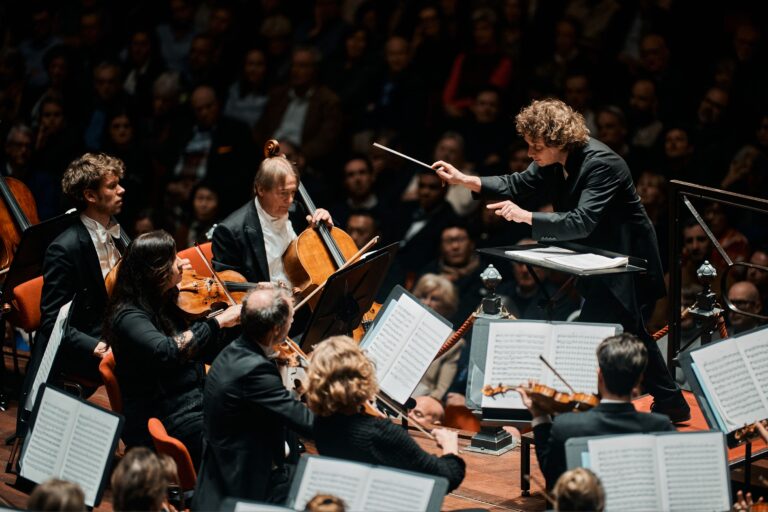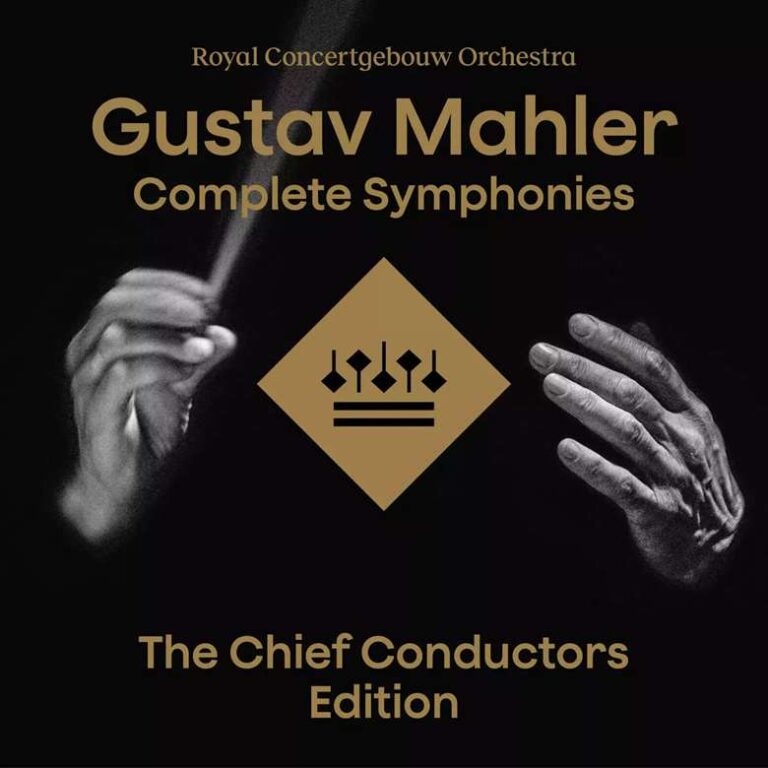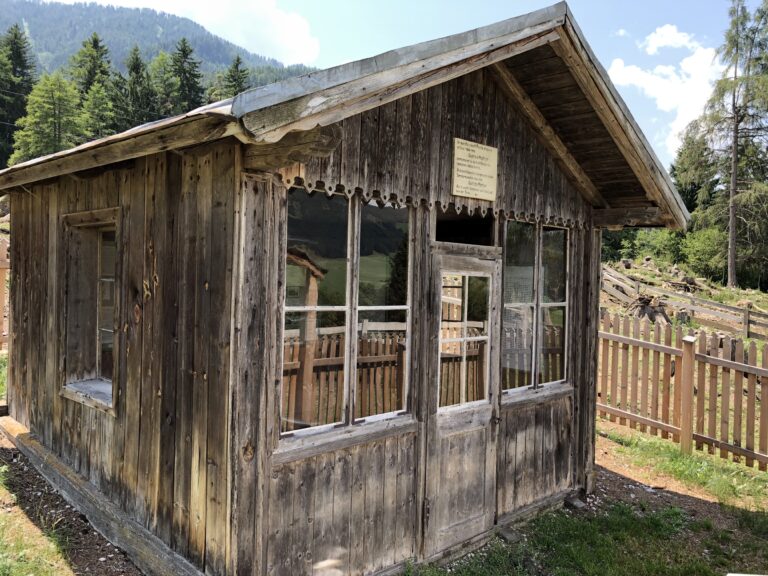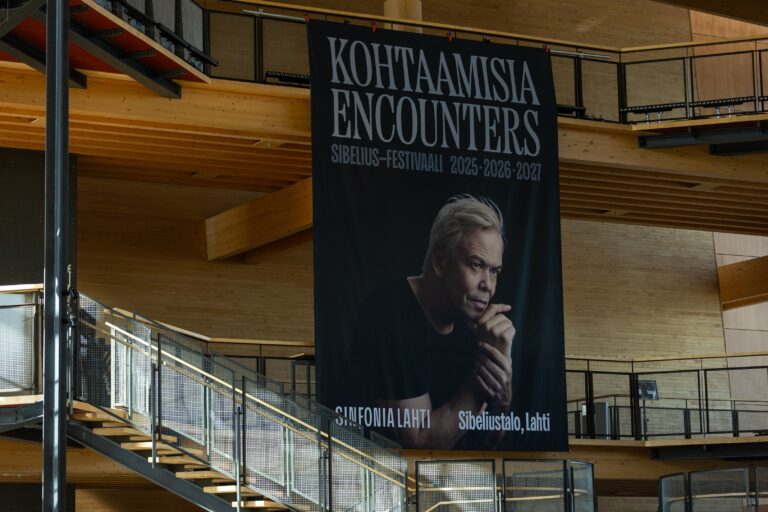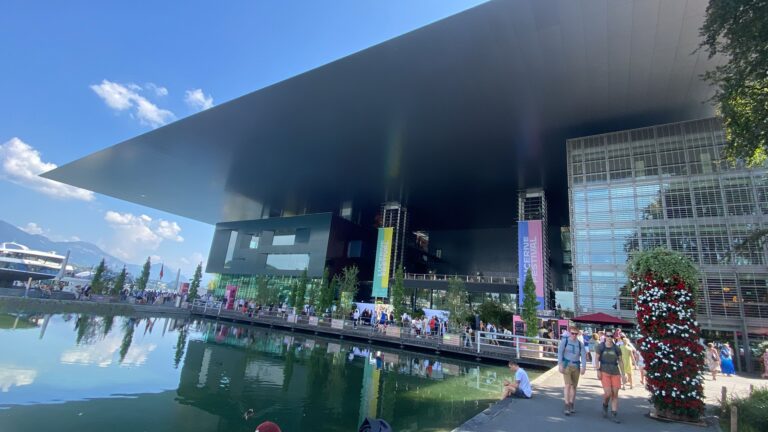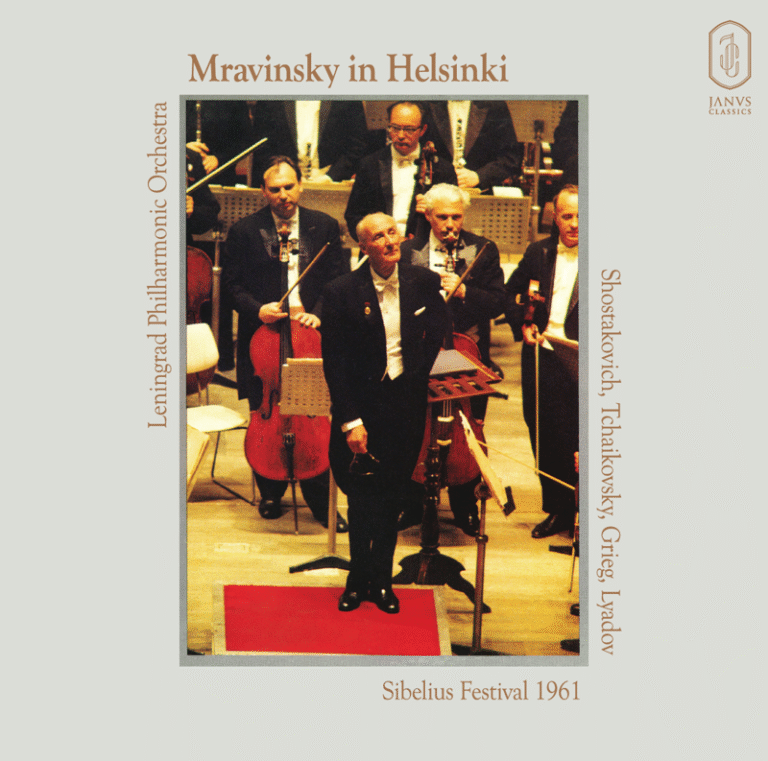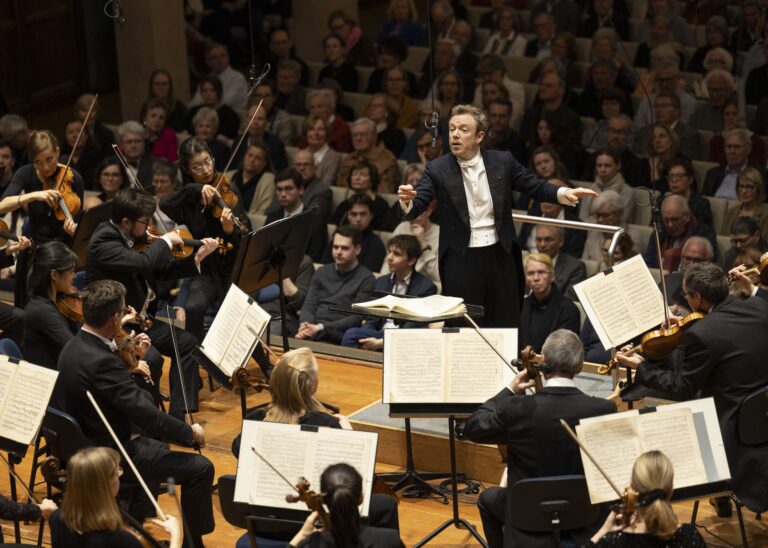An evening of contrasts and orchestral mastery at the Concertgebouw. Santtu-Matias Rouvali led the Royal Concertgebouw Orchestra in a striking program featuring Anna Clyne’s Fractured Time, Rachmaninoff’s Third Piano Concerto with Kirill Gerstein, and Sibelius’s monumental Fifth Symphony. A performance of breathtaking clarity, intensity, and poetic grandeur.
PROGRAM:
Royal Concertgebouw, Amsterdam
Main Hall (Grote Zaal)
Royal Concertgebouw Orchestra
Conductor: Santtu-Matias Rouvali
Piano: Kirill Gerstein
- Anna Clyne, Fractured Time
- Sergei Rachmaninoff, Piano Concerto No. 3 in D minor, Op. 30
- Jean Sibelius Symphony No. 5 in E-flat major, Op. 82
The Royal Concertgebouw Orchestra is one of those rare ensembles where every phrase carries a sense of history, every chord seems carefully placed in the grand tradition of symphonic music. Under the baton of Santtu-Matias Rouvali, it becomes something even more—an organic, breathing entity, a living soundscape where the music unfolds as naturally as if it were forming in real time. This evening’s program—Anna Clyne, Rachmaninoff, and Sibelius—was not just a sequence of works but a carefully shaped journey, from the fractured modernism of Clyne to the symphonic opulence of Rachmaninoff and the elemental grandeur of Sibelius.
There was no sense of opposition in the programming but rather a natural evolution. The restless energy of Clyne’s work found its answer in Rachmaninoff’s deeply structured yet fluid writing, and finally, Sibelius emerged as a force of nature, where form and sound merged into something greater than itself.
Anna Clyne – Fractured Time and Shattered Perception
Anna Clyne’s Fractured Time is not an easy work to place. It plays with the very idea of pulse, of musical continuity, breaking apart lines, reassembling them, creating a sense of momentum that is constantly disrupted. Rouvali took the piece with absolute seriousness, shaping it not as a collection of effects but as a coherent, evolving structure.
The orchestration, relatively lean in comparison to what followed, allowed for moments of striking clarity. The string writing, full of glissandi and quicksilver gestures, was handled with precision by the Concertgebouw musicians, while the brass created angular, almost percussive statements that cut through the haze of shifting harmonies. The work at times evoked the sudden rhythmic shifts of Stravinsky, the layered colors of Messiaen, and the haunting luminosity of Britten, but Clyne’s voice remained her own, unmistakable in its interplay of motion and suspension.
Rouvali conducted with a sculptor’s precision. His control over phrasing and balance allowed the dense textures to breathe, giving the music a sense of forward motion even as it seemed to disintegrate in front of us. The final bars, cutting off abruptly, left the hall in a stunned silence—an unresolved question hanging in the air. It was the perfect opening statement for an evening built on contrasts.
Rachmaninoff – The Orchestral Piano, The Pianistic Orchestra
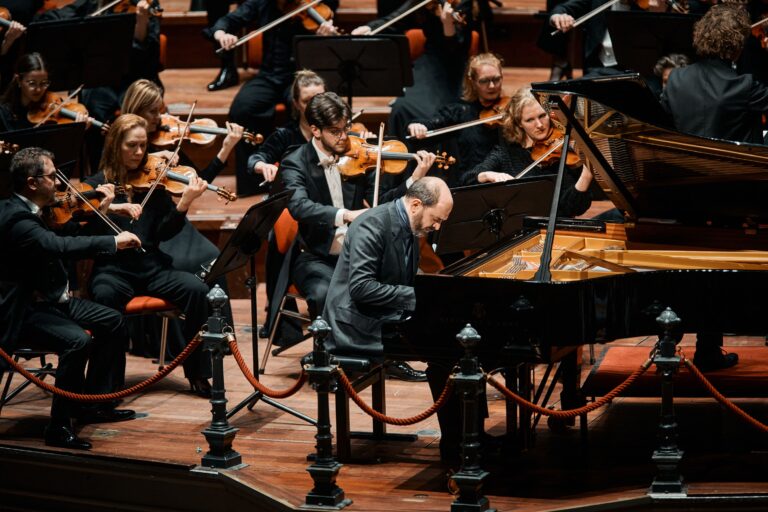
Rachmaninoff’s Third Piano Concerto is often seen as a monumental challenge, a test of endurance and control where virtuosity alone is not enough. Kirill Gerstein approached it with remarkable intelligence, crafting a reading that was as much about architecture as it was about expressivity. There was no unnecessary grandeur, no forced drama—only a natural, fluid dialogue between piano and orchestra.
From the opening measures, Gerstein shaped the initial theme with a sense of introspective lyricism, resisting any temptation to rush. His phrasing was supple, allowing the melody to emerge like a distant memory. The Royal Concertgebouw Orchestra, under Santtu-Matias Rouvali’s attentive yet unobtrusive direction, provided a backdrop of exceptional warmth and clarity. The balance was impeccable, with the strings enveloping Gerstein’s lines in a velvet cushion of sound, while the winds added delicate nuances.
A standout moment came with the bassoon solo, played by Gustavo Núñez, which introduced a striking contrast of color. The depth and phrasing of his playing reinforced the movement’s sense of longing. Laurens Woudenberg, on solo horn, brought an understated nobility to his entries, particularly in the second movement, where his tone provided a perfect counterweight to the more intricate piano passages.
Gerstein’s handling of the first movement’s cadenza was revelatory. Rather than attacking it as a mere technical display, he emphasized its harmonic depth and inner voices, treating it as an organic extension of the movement’s larger arc. The return of the main theme, after the turbulence of the development, felt less like a victorious statement and more like a sigh of reflection, a moment of reprieve before the final surge forward.
The second movement, often seen as a lyrical interlude, became a deeply introspective moment under Gerstein’s hands. He understood that this was not simply a moment of respite but a space where the piano converses with the orchestra in ever-shifting emotional shades. Rouvali kept the orchestral textures transparent, allowing individual voices to emerge with clarity.
The transition to the third movement was seamless, as if the music itself had been holding its breath before plunging into its final, electrifying sprint. The finale unfolded with an exhilarating sense of inevitability—every phrase logically leading to the next, every accent precisely placed yet never rigid. Gerstein’s articulation was astonishingly clear, each note ringing with crystalline precision even in the most densely orchestrated sections. Rouvali, never one to let momentum slip, ensured that the orchestra moved as one with the soloist, keeping the intricate interplay between strings, brass, and piano taut yet organic.
By the final cadenza, there was no doubt—this was a reading that balanced raw energy with supreme control. The last chords, hammered out with absolute conviction, brought the hall into an immediate standing ovation. Gerstein had not just conquered the concerto; he had revealed it, exposing every layer of its intricate design without ever losing its soaring grandeur.
At the conclusion of Rachmaninoff’s relentless, electrifying Third Concerto, Kirill Gerstein offered the audience a moment of pure contemplation with his encore: Morceaux de fantaisie, also by Rachmaninoff.
After the storm, this piece felt like a deep breath, a return to introspection and lyricism, as if Gerstein were offering a quiet epilogue to the concerto’s emotional tumult. His touch was exquisitely delicate, allowing the phrases to unfold with a Schubertian intimacy, each note carrying the weight of reflection rather than display.
The contrast was striking—where the concerto had been about vast orchestral grandeur and technical athleticism, the encore became a space for stillness. Gerstein’s phrasing was unhurried, each chord voiced with clarity and warmth, inviting the audience to listen inwards. The moment lingered, as if time had momentarily stretched, before fading into silence. A perfect way to close his performance, leaving the audience in a state of quiet admiration.
Sibelius' Fifth Symphony: the Nordic epic reimagined

There is something elemental about Sibelius’s Fifth Symphony, as if the music is not so much composed as carved from the landscape itself. It is a symphony that breathes with the rhythm of nature—winds sweeping over vast plains, water shifting under ice, sunlight piercing through dense forests. It is a work that requires not just precision but vision, an understanding of how silence and sound interact, how momentum must build organically rather than be imposed.
Santtu-Matias Rouvali, with his deep Finnish roots, approached the work with a sense of inevitability, letting it unfold as though it were being discovered in the moment. His interpretation was strikingly different from those who seek to monumentalize Sibelius, turning it into a grand architectural structure. Instead, Rouvali shaped it with an almost weightless fluidity, closer to the logic of wind and tide than to the rigidity of classical form.
In this, Rouvali stands in contrast to his teacher, Leif Segerstam. If Segerstam is the Väinämöinen of Finnish conducting—a wild, shamanic bard conjuring raw elemental forces—Rouvali is the elf, precise, agile, shaping the music with effortless grace. His hands, moving with an almost dancer-like elegance, seemed to sculpt the air itself, drawing out textures that shimmered and glowed rather than simply resounding.
The first movement did not burst forth but rather emerged, like dawn gradually illuminating a vast landscape. The swirling figures in the strings created an impression of endless motion, their phrasing light yet never lacking in depth. But it was in the central section that Rouvali revealed the true modernity of this symphony, where the music seems to hesitate between worlds, caught between the ghostly, errant whispers of the violins and the bassoon’s lonely, searching song. Here, Sibelius seems to be writing in the language of the Seventh Symphony or even Tapiola, evoking a rarefied, airless atmosphere, suffocating in its insidious tension, broken only by sudden, jagged orchestral outbursts. This passage felt like a premonition, a bridge to a future Sibelius had not yet reached, and Rouvali shaped it with an uncanny understanding of its fragile, suspended nature. As the movement regained momentum, Rouvali’s control of pacing was impeccable, allowing the Wagnerian echoes of the final measures to prepare the breathtaking climax—a Finnish Valhalla conjured in orchestral form. The energy was so electrifying that it was nearly impossible to suppress applause before the music had fully settled.
The second movement was a study in contrasts—delicate yet full of underlying strength. The interplay between the winds and strings took on a chamber-like intimacy, each phrase sculpted with care. Rouvali gave the music ample space to breathe, allowing its inner poetry to shine through. There was something of a choral quality to the orchestral blend, as if each line were being sung rather than played. The pacing here was slower than some interpretations, but never static—this was Sibelius seen as a landscape in slow motion, with every detail given its due. Rouvali seemed to instinctively feel the organic pulse of this movement, shaping each phrase as if he were revealing the very cellular structure of the music. It was a true work of craftsmanship, a masterful balance between structural integrity and expressive depth, demonstrating a maturity beyond his years.
Then came the finale, a movement that is at once a force of nature and a carefully constructed architectural marvel. Rouvali took it at a brisk yet unforced pace, ensuring that the tension never faltered. The violins shimmered like the light on northern waters, while the wind writing evoked the rustling leaves of the birch trees of Lapland and Karelia, an element so essential to understanding the life force within this symphony. The orchestration, both lean and powerful, seemed to pivot Sibelius toward a new musical language—one where the folkloric energy of the past meets the distilled modernism of his late works. The double basses, their bows striking with percussive force, added a raw, almost primal foundation beneath the soaring lines above.
As the symphony reached its culmination, Rouvali’s control over the final six chords was a masterclass in pacing and weight. Each statement landed with absolute conviction, each silence ringing with meaning. It was not a conclusion but an arrival, a sense of having reached something vast and unknowable. The audience, sensing the magnitude of what had just unfolded, erupted in a standing ovation, recognizing not only the brilliance of Sibelius’s creation but the sheer vision with which Rouvali had brought it to life.
This was not just a concert—it was an ascent. From the relentless momentum of Clyne’s fractured time to the towering waves of Rachmaninoff and the Nordic immensity of Sibelius, Rouvali and the Royal Concertgebouw Orchestra summoned forces that felt beyond the sum of their parts. Gerstein, with a pianist’s soul and an architect’s mind, revealed new dimensions in Rachmaninoff’s Third, while Rouvali, guiding Sibelius’s Fifth like a force of nature, proved that some music is not played—it is unleashed.
As Sibelius himself once wrote, “Music begins where the possibilities of language end.” Tonight, words fell short. The music spoke, and it was unstoppable.


